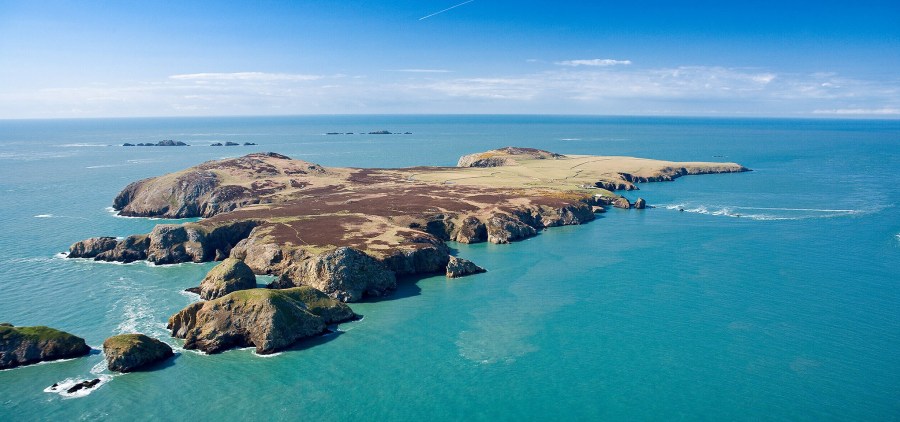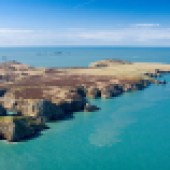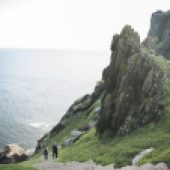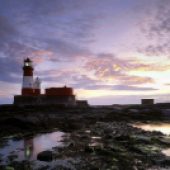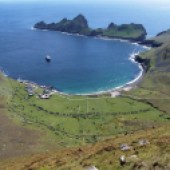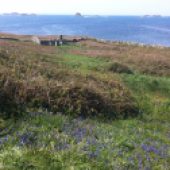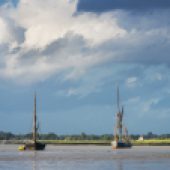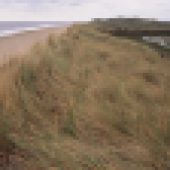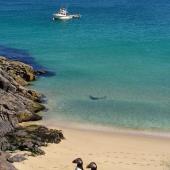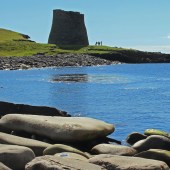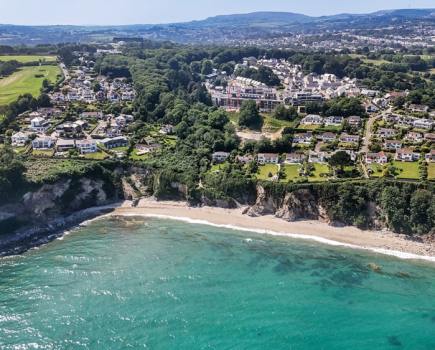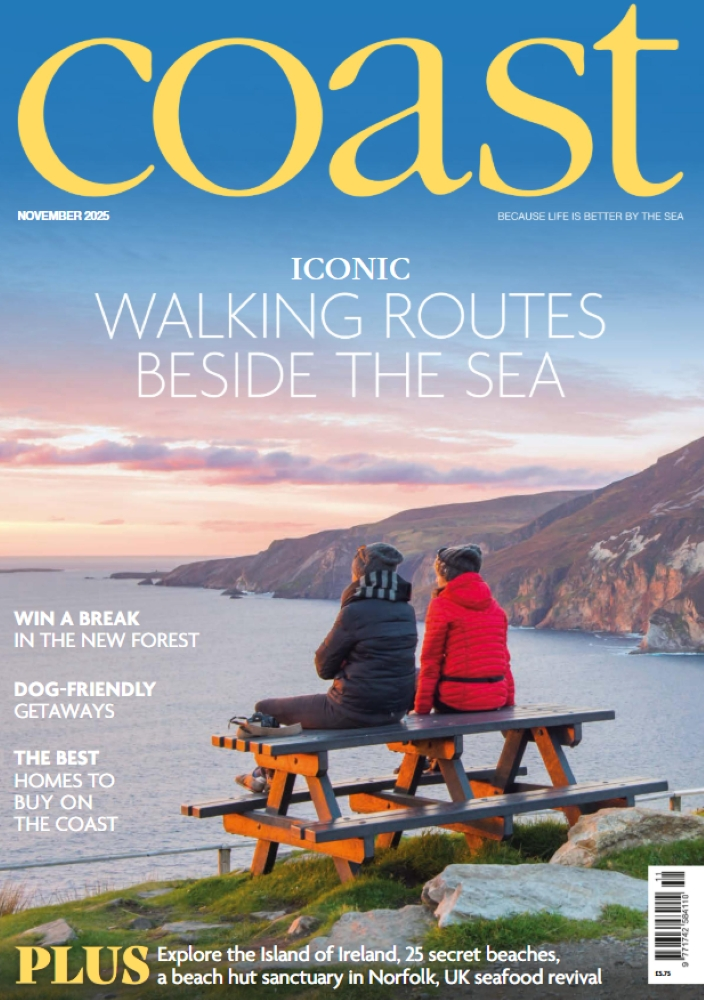Escape modern life entirely on a visit to one of these remarkable islands. Marvel at seabird cities, explore monastic ruins or live like a castaway for a weekend.
Words: Alex Reece
1. FOR CLIFFS & CHOUGHS
Ramsey Island, Pembrokeshire
Many visitors to Ramsey Island, an RSPB reserve off the St Davids Peninsula, come especially to see the chough. And family groups of this rare but charismatic bird, with its charcoal plumage, and scarlet bill and legs, are visible at this time of year. Another draw is the island’s spiritual heritage – Ramsey was once a holy site for pilgrims, and there are burial cairns on the 120m-high hills. On arrival at the harbour, chat to the resident wardens, who will point out the seasonal must-sees. The main circular route is 3.5 miles long, but shorter loops are available. Bring a packed lunch (there are toilets and a tuck shop on the island) and see if you can spot seabirds, grey seals or wildflowers, such as pink thrift, en route. rspb.org.uk/thousandislands.co.uk
2. FOR RUGGED REMAINS
Skellig Islands, Co Kerry
Intrepid travellers will relish the thrill of landing at Skellig Michael, the larger of these two islands, 45 minutes off Co Kerry. The landing stage is partly inside a sea cave, and from there, you climb 660 stone steps – without a hand rail – to reach the top of the island. The pay-off is the chance to explore the incredible, rugged remains of a monastic settlement dating back to the 6th century, now a UNESCO World Heritage Site. Peek inside six beehive cells where monks lived before leaving the island for good in the 1300s. The otherworldly setting was also used as a location for the newest Star Wars film. skelligislands.com/ireland.com
3. FOR SEABIRD ENCOUNTERS
Farne Islands, Northumberland
Being dive-bombed by Arctic terns guarding their eggs is just one of the memorable encounters you’re likely to have on the Farne Islands. ‘You’re really in their world,’ says head ranger Becky Hetherington, who flags up fulmars, sandwich terns, puffins, razorbills, kittiwakes and guillemots as other star species to look out for. Inner Farne has a boardwalk route for visitors arriving from Seahouses. See the remains of the cell where St Cuthbert lived in the 7th century, and St Cuthbert’s Chapel. Elsewhere in the Farnes, the Longstone lighthouse is famous for the 1838 rescue of the Forfarshire shipwreck survivors by Grace Darling and her lighthouse-keeper father. nationaltrust.org.uk/farne-islands
4. FOR ONE TO REMEMBER
St Kilda, Outer Hebrides
On a day trip to this far-flung archipelago, a three- to four-hour sailing from Skye or the Western Isles, take in the sounds and smells of what Susan Bain, Western Isles area manager at the National Trust for Scotland, describes as a ‘seabird city’, including the largest puffin and fulmar colonies in Britain. Among other highlights at the UK’s only ‘mixed’ UNESCO World Heritage site – for its cultural and natural importance – are two varieties of wild sheep, Soay and Boreray, brought here by the first settlers 4-5,000 years ago. Walk around the abandoned village on the main island of Hirta (evacuated in 1930, due to a declining population), where there is a museum in one of the dwellings. nts.org.uk/kilda.org.uk
5. FOR A BIT OF EVERYTHING
Samson, Isles of Scilly
The appeal of Samson – the largest uninhabited island in the Scilly Isles – lies in the fact that it ‘has a bit of everything,’ says archaeologist and walking guide Katharine Sawyer (scillywalks.co.uk). The two hills on the island both house Bronze Age burial chambers, while the later buildings – left by the few remaining islanders in the 1850s – give a flavour of what life might have been like, with fireplaces and storage cupboards still surviving in some of them. Another feature is the deer park boundary, built by Lord Proprietor of Scilly, Augustus Smith, in the mid-19th century. Rare wildflowers, such as pyramidal orchids, thrive in this setting (which has no facilities), making it an idyllic, wild place for a summer picnic. visitislesofscilly.com/scillyboating.co.uk
Looking for the perfect holiday right at the water’s edge? Discover our collection of exclusive cruise trips around the British Isles here.
6. FOR A FESTIVAL VIBE
Northey Island, Essex
Access to Northey – a remote island in the Blackwater Estuary, with just two houses (one a holiday let and another for volunteers) – is by appointment only, on account of breeding birds and the tidal causeway. However, every summer, the Castaway weekend held by the National Trust invites campers to see what it’s like to be marooned in the Essex wilderness come high tide. Past events have included talks by Essex Wildlife Trust, live music and a beer tent with local real ales. Tickets cost around £22 per person. nationaltrust.org.uk/northey-island
7. FOR VAST SAND DUNES
Scolt Head Island, North Norfolk
One of the best ways to view this island off the North Norfolk coast is from the terrace located at the back of the White Horse Inn in Brancaster Staithe. Look across the saltmarshes and the waves to the vast dunes that make up Scolt Head National Nature Reserve. A seasonal ferry runs from Burnham Overy Staithe, which lands at the eastern end of this four-mile-long barrier island, where there’s a beach. Access to the western end is restricted, due to its international importance as a breeding site for rare birds, such as terns and ringed plover. ‘We have the largest ringed plover population in England on Scolt Head,’ explains Natural England senior reserve manager, Michael Rooney. gov.uk/government/publications/norfolks-national-nature-reserves
8. FOR A SECRET BEACH
Mingulay, Berneray and Pabbay, Outer Hebrides
With a similar story to St Kilda, Mingulay – at the southern tip of the Western Isles, accessible by boat from Barra – was deserted by its dwindling inhabitants in 1912. Today, it’s possible to wander through what remains of the village to the sandy beach of Mingulay Bay, a favoured basking spot for seals, which come here in their thousands. Nearby Pabbay (abandoned at the same time) is renowned for its Pictish stone. These are more commonly found on the east coast. Berneray, also known as Barra Head, has a lighthouse built by Robert Stevenson and an evocative graveyard for past keepers and their families. nts.org.uk
9. FOR A TOWERING LANDMARK
Mousa, Shetland Islands
On the to-do list for many Shetland holidaymakers is an evening boat trip to Mousa, to watch hundreds of tiny storm petrels return to the island after days feeding out at sea. ‘The night-time experience on Mousa is magical,’ confirms Helen Moncrieff, Shetland manager for the RSPB. However, visiting in the daytime is pretty special, too; you’ll get a snapshot of 5,000 years of human occupancy – the pinnacle of which is the 13m-high Iron Age broch or tower, affording views as far as Sumburgh Head on Mainland. Trailmarkers guide you around the island, which was last inhabited in the 1800s and is now an RSPB reserve. Look out for wetland plants (such as the insectivorous butterwort), as well as great skuas (or bonxies), and the unusual sight of both grey and common seals together in one place. mousa.co.uk/rspb.org.uk
Don’t miss our 10 best child-friendly beaches .
Don’t miss our 10 best child-friendly beaches and 10 best potteries by the sea.
Escape modern life entirely on a visit to one of these remarkable islands. Marvel at seabird cities, explore monastic ruins or live like a castaway for a weekend.
Words: Alex Reece
1. FOR CLIFFS & CHOUGHS
Ramsey Island, Pembrokeshire
Many visitors to Ramsey Island, an RSPB reserve off the St Davids Peninsula, come especially to see the chough. And family groups of this rare but charismatic bird, with its charcoal plumage, and scarlet bill and legs, are visible at this time of year. Another draw is the island’s spiritual heritage – Ramsey was once a holy site for pilgrims, and there are burial cairns on the 120m-high hills. On arrival at the harbour, chat to the resident wardens, who will point out the seasonal must-sees. The main circular route is 3.5 miles long, but shorter loops are available. Bring a packed lunch (there are toilets and a tuck shop on the island) and see if you can spot seabirds, grey seals or wildflowers, such as pink thrift, en route. rspb.org.uk/thousandislands.co.uk
2. FOR RUGGED REMAINS
Skellig Islands, Co Kerry
Intrepid travellers will relish the thrill of landing at Skellig Michael, the larger of these two islands, 45 minutes off Co Kerry. The landing stage is partly inside a sea cave, and from there, you climb 660 stone steps – without a hand rail – to reach the top of the island. The pay-off is the chance to explore the incredible, rugged remains of a monastic settlement dating back to the 6th century, now a UNESCO World Heritage Site. Peek inside six beehive cells where monks lived before leaving the island for good in the 1300s. The otherworldly setting was also used as a location for the newest Star Wars film. skelligislands.com/ireland.com
3. FOR SEABIRD ENCOUNTERS
Farne Islands, Northumberland
Being dive-bombed by Arctic terns guarding their eggs is just one of the memorable encounters you’re likely to have on the Farne Islands. ‘You’re really in their world,’ says head ranger Becky Hetherington, who flags up fulmars, sandwich terns, puffins, razorbills, kittiwakes and guillemots as other star species to look out for. Inner Farne has a boardwalk route for visitors arriving from Seahouses. See the remains of the cell where St Cuthbert lived in the 7th century, and St Cuthbert’s Chapel. Elsewhere in the Farnes, the Longstone lighthouse is famous for the 1838 rescue of the Forfarshire shipwreck survivors by Grace Darling and her lighthouse-keeper father. nationaltrust.org.uk/farne-islands
4. FOR ONE TO REMEMBER
St Kilda, Outer Hebrides
On a day trip to this far-flung archipelago, a three- to four-hour sailing from Skye or the Western Isles, take in the sounds and smells of what Susan Bain, Western Isles area manager at the National Trust for Scotland, describes as a ‘seabird city’, including the largest puffin and fulmar colonies in Britain. Among other highlights at the UK’s only ‘mixed’ UNESCO World Heritage site – for its cultural and natural importance – are two varieties of wild sheep, Soay and Boreray, brought here by the first settlers 4-5,000 years ago. Walk around the abandoned village on the main island of Hirta (evacuated in 1930, due to a declining population), where there is a museum in one of the dwellings. nts.org.uk/kilda.org.uk
5. FOR A BIT OF EVERYTHING
Samson, Isles of Scilly
The appeal of Samson – the largest uninhabited island in the Scilly Isles – lies in the fact that it ‘has a bit of everything,’ says archaeologist and walking guide Katharine Sawyer (scillywalks.co.uk). The two hills on the island both house Bronze Age burial chambers, while the later buildings – left by the few remaining islanders in the 1850s – give a flavour of what life might have been like, with fireplaces and storage cupboards still surviving in some of them. Another feature is the deer park boundary, built by Lord Proprietor of Scilly, Augustus Smith, in the mid-19th century. Rare wildflowers, such as pyramidal orchids, thrive in this setting (which has no facilities), making it an idyllic, wild place for a summer picnic. visitislesofscilly.com/scillyboating.co.uk
6. FOR A FESTIVAL VIBE
Northey Island, Essex
Access to Northey – a remote island in the Blackwater Estuary, with just two houses (one a holiday let and another for volunteers) – is by appointment only, on account of breeding birds and the tidal causeway. However, every summer, the Castaway weekend held by the National Trust invites campers to see what it’s like to be marooned in the Essex wilderness come high tide. Past events have included talks by Essex Wildlife Trust, live music and a beer tent with local real ales. Tickets cost around £22 per person. nationaltrust.org.uk/northey-island
7. FOR VAST SAND DUNES
Scolt Head Island, North Norfolk
One of the best ways to view this island off the North Norfolk coast is from the terrace located at the back of the White Horse Inn in Brancaster Staithe. Look across the saltmarshes and the waves to the vast dunes that make up Scolt Head National Nature Reserve. A seasonal ferry runs from Burnham Overy Staithe, which lands at the eastern end of this four-mile-long barrier island, where there’s a beach. Access to the western end is restricted, due to its international importance as a breeding site for rare birds, such as terns and ringed plover. ‘We have the largest ringed plover population in England on Scolt Head,’ explains Natural England senior reserve manager, Michael Rooney. gov.uk/government/publications/norfolks-national-nature-reserves
8. FOR A SECRET BEACH
Mingulay, Berneray and Pabbay, Outer Hebrides
With a similar story to St Kilda, Mingulay – at the southern tip of the Western Isles, accessible by boat from Barra – was deserted by its dwindling inhabitants in 1912. Today, it’s possible to wander through what remains of the village to the sandy beach of Mingulay Bay, a favoured basking spot for seals, which come here in their thousands. Nearby Pabbay (abandoned at the same time) is renowned for its Pictish stone. These are more commonly found on the east coast. Berneray, also known as Barra Head, has a lighthouse built by Robert Stevenson and an evocative graveyard for past keepers and their families. nts.org.uk
9. FOR A TOWERING LANDMARK
Mousa, Shetland Islands
On the to-do list for many Shetland holidaymakers is an evening boat trip to Mousa, to watch hundreds of tiny storm petrels return to the island after days feeding out at sea. ‘The night-time experience on Mousa is magical,’ confirms Helen Moncrieff, Shetland manager for the RSPB. However, visiting in the daytime is pretty special, too; you’ll get a snapshot of 5,000 years of human occupancy – the pinnacle of which is the 13m-high Iron Age broch or tower, affording views as far as Sumburgh Head on Mainland. Trailmarkers guide you around the island, which was last inhabited in the 1800s and is now an RSPB reserve. Look out for wetland plants (such as the insectivorous butterwort), as well as great skuas (or bonxies), and the unusual sight of both grey and common seals together in one place. mousa.co.uk/rspb.org.uk
Don’t miss our 10 best child-friendly beaches .
Don’t miss our 10 best child-friendly beaches and 10 best potteries by the sea.

